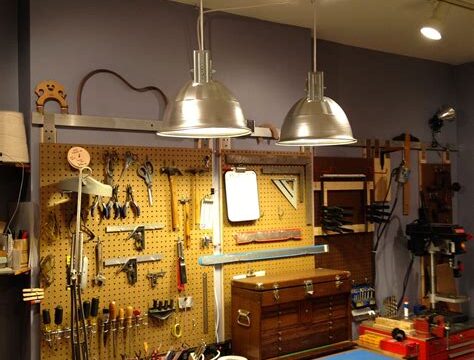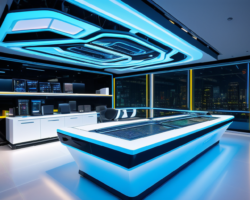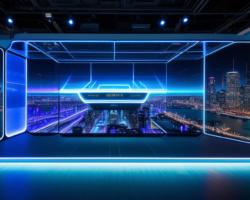Enhancing Productivity with Adequate Lighting
Lighting plays a crucial role in our daily lives, including our work environments. Adequate lighting not only ensures clear visibility but also has a profound impact on productivity. Various studies have shown that well-lit spaces contribute to increased focus, reduced eye strain, and improved overall performance. In this blog post, we will explore the importance of adequate lighting in enhancing productivity and provide tips on how to achieve optimal lighting conditions in your workspace.
To begin with, proper lighting creates an atmosphere that promotes alertness and concentration. Bright and well-distributed light stimulates the brain and helps individuals stay focused on their tasks. On the other hand, dim or inadequate lighting can lead to drowsiness and decreased productivity. Therefore, investing in high-quality lighting fixtures such as LED panels or task lighting is essential to maintain optimal brightness levels in your workspace.
Additionally, clear visibility provided by adequate lighting is crucial in preventing accidents and injuries. A well-lit environment allows employees to navigate safely, minimizing the risk of tripping or colliding with objects. Moreover, good lighting conditions can significantly reduce eye strain, which is a common problem experienced by individuals who spend long hours working on screens or performing detailed tasks. Balanced lighting that minimizes glare and provides sufficient contrast can help alleviate eye fatigue and maintain comfort throughout the workday.
- Choose lighting fixtures that provide the right amount of brightness for your specific tasks. Consider task lighting for focused work areas, ambient lighting for general illumination, and accent lighting for enhancing aesthetics.
- Take advantage of natural light sources whenever possible. Position workstations near windows or incorporate skylights to bring in daylight, which has been proven to improve mood and productivity.
- Adjust the lighting levels in your workspace according to the time of day. Use dimmable lights or implement lighting control systems that allow you to optimize brightness based on natural daylight and individual preferences.
| Benefits of Adequate Lighting in the Workplace |
|---|
| Enhanced focus and concentration |
| Reduced eye strain and fatigue |
| Improved safety and accident prevention |
| Increased overall productivity |
| Aesthetically pleasing work environment |
Creating a well-lit work environment not only benefits individual productivity but also enhances the overall aesthetics of your workspace. Proper lighting design can transform a dull and uninspiring workplace into a vibrant and visually appealing area. Consider incorporating different lighting techniques, such as task lighting and accent lighting, to highlight specific areas or create a welcoming ambiance. A thoughtfully designed lighting arrangement can contribute to a more enjoyable and productive work experience for employees.
In conclusion, adequate lighting is a key factor in enhancing productivity in the workplace. It promotes focus, prevents accidents, reduces eye strain, and improves overall performance. By investing in the right lighting fixtures, utilizing natural light sources, and adjusting lighting levels accordingly, you can create an optimal work environment that fosters productivity and well-being. So, let there be light!
Preventing Accidents with Clear Visibility
Accidents can happen anytime and anywhere, especially in a workspace where there are various types of tools, equipment, and substances that can pose potential risks. One way to prevent accidents is by ensuring clear visibility in the work environment. Adequate lighting plays a crucial role in maintaining a safe workplace and reducing the chances of accidents.
Firstly, proper lighting helps to eliminate any potential hazards that may be lurking in the shadows. When the workspace is well-lit, workers are able to see their surroundings clearly, including any obstacles or tripping hazards. This is especially important in areas with uneven flooring, steps, or cluttered workstations. With clear visibility, employees are less likely to stumble and fall, reducing the risk of injuries.
Additionally, adequate lighting enhances visibility of warning signs, labels, and safety instructions. In a well-lit environment, these crucial pieces of information can be easily seen and understood by employees. This ensures that workers are aware of potential dangers, proper procedures, and safety precautions. It also helps them identify emergency exits and firefighting equipment quickly, allowing for a prompt response in case of an emergency situation.
- Improved visibility: Adequate lighting helps workers see their surroundings clearly, reducing the chances of accidents.
- Reduction of tripping hazards: Clear visibility helps employees identify any obstacles or cluttered areas, preventing trips and falls.
- Enhanced understanding of safety instructions: Proper lighting ensures that warning signs, labels, and safety instructions are easily visible, increasing awareness and adherence to safety protocols.
| Lighting Fixture | Benefits |
|---|---|
| LED lights | Energy-efficient, long-lasting, and provides bright, focused lighting. |
| Fluorescent lights | Cost-effective, widely available, and suitable for larger workspaces. |
| Task lighting | Provides concentrated lighting for specific work areas, reducing eye strain. |
| Motion sensor lights | Automatically turns on when someone enters the vicinity, enhancing safety and energy efficiency. |
It is crucial to choose the right lighting fixtures for optimal conditions in the workplace. LED lights are highly recommended as they are energy-efficient, long-lasting, and provide bright, focused lighting. They are particularly suitable for workspaces where visual tasks are performed, such as reading small prints or working with intricate details. Fluorescent lights are another popular choice, as they are cost-effective and provide general lighting for larger areas.
For specific work areas, task lighting can be used to provide concentrated lighting. This helps to reduce eye strain and allows workers to focus better on their tasks. Additionally, motion sensor lights can be installed to automatically turn on when someone enters the vicinity. This not only enhances safety by ensuring well-lit pathways but also promotes energy efficiency by minimizing unnecessary energy consumption.
In conclusion, preventing accidents in the workplace requires clear visibility, which can be achieved through adequate lighting. By eliminating potential hazards, improving visibility of safety instructions, and choosing the right lighting fixtures, employers can create a safer work environment for their employees. Prioritizing clear visibility not only reduces the risk of injuries but also promotes productivity and overall well-being in the workplace.
Choosing the Right Lighting Fixtures for Optimal Conditions
When it comes to creating the perfect lighting conditions, it is essential to choose the right lighting fixtures. Proper lighting not only enhances visibility but also plays a crucial role in improving productivity and creating a safe working environment. In this blog post, we will discuss the factors to consider when selecting lighting fixtures for optimal conditions.
One of the key considerations when choosing lighting fixtures is the color temperature. Color temperature is measured in Kelvin and determines the warmth or coolness of the light produced. For optimal conditions, it is recommended to select lighting fixtures with a color temperature of around 5000-6500 Kelvin. This range provides a bright, daylight-like light that promotes alertness and focus.
Another important factor to consider is the light output of the fixtures. The light output is measured in lumens, and for optimal conditions, it is crucial to choose fixtures that produce adequate light. Factors such as the size of the space and the tasks performed in it should be taken into account to determine the required light output. Using luminaires with adjustable light output can be beneficial as it allows for flexibility in different lighting scenarios.
- Color temperature should be in the range of 5000-6500 Kelvin for optimal lighting conditions.
- Consider the light output of the fixtures based on the size of the space and tasks performed.
- Ensure the lighting fixtures have appropriate glare control to avoid discomfort and improve visibility.
- Pay attention to the color rendering index (CRI) of the lighting fixtures. A CRI of 80 or above is recommended for accurate color representation.
- Opt for energy-efficient lighting fixtures, such as LED, to reduce energy consumption and costs.
Furthermore, it is crucial to consider the glare control provided by the lighting fixtures. Glare can cause discomfort and reduce visibility, impacting productivity and overall well-being. Fixtures equipped with diffusers, lens covers, or adjustable louvers can help minimize glare and provide a comfortable working environment.
Additionally, the color rendering index (CRI) of the lighting fixtures should not be overlooked. CRI measures the accuracy with which a light source reveals the colors of objects. For optimal conditions, a CRI of 80 or above is recommended to ensure accurate color representation, especially in tasks that require color differentiation.
Lastly, selecting energy-efficient lighting fixtures is not only environmentally friendly but also helps reduce energy consumption and costs. LED fixtures, for example, are known for their energy efficiency, long lifespan, and low maintenance requirements. Considering these factors when choosing lighting fixtures will help create optimal conditions that enhance productivity and contribute to a safe and comfortable working environment.
| Factor | Considerations |
|---|---|
| Color Temperature | 5000-6500 Kelvin for optimal conditions |
| Light Output | Determine based on space size and tasks performed |
| Glare Control | Ensure fixtures have appropriate glare control mechanisms |
| Color Rendering Index (CRI) | Opt for fixtures with CRI of 80 or above for accurate color representation |
| Energy Efficiency | Choose energy-efficient options like LED fixtures |
Creating a Safe Working Environment through Proper Illumination
In today’s fast-paced and demanding work environment, it is crucial to prioritize safety in every aspect. One often overlooked factor that greatly contributes to a safe working environment is proper illumination. By implementing appropriate lighting measures, employers can minimize accidents, reduce eye strain, and ensure that employees can effectively perform their tasks. In this blog post, we will explore the importance of creating a safe working environment through proper illumination and provide valuable insights and tips on how to achieve optimal lighting conditions.
First and foremost, adequate lighting is essential for preventing accidents in the workplace. Insufficient lighting can lead to tripping hazards, increase the likelihood of collisions, and impair employees’ ability to navigate their surroundings safely. By strategically placing light fixtures in key areas such as hallways, staircases, and workstations, employers can significantly reduce the risk of accidents and promote a safe work environment.
Additionally, choosing the right lighting fixtures is crucial for creating optimal work conditions. Different tasks require varying levels of illumination, and it is essential to match the lighting intensity with the nature of the work being performed. For instance, tasks that involve detailed work or reading small print necessitate brighter lighting, while areas where employees relax or take breaks may benefit from softer, dimmer lighting. By understanding the specific lighting needs of each workspace, employers can select the appropriate fixtures, such as overhead lights, task lights, or adjustable lamps, to ensure optimal visibility and minimal eye strain.
| Benefits of Proper Illumination: |
|---|
| 1. Improved productivity: Adequate lighting helps employees stay alert and focused, leading to increased productivity levels. |
| 2. Reduced eye strain: Proper lighting reduces the strain placed on employees’ eyes, minimizing the risk of fatigue and vision problems. |
| 3. Enhanced safety: Well-lit work areas eliminate potential hazards, preventing accidents and injuries in the workplace. |
| 4. Increased morale: Creating a well-lit and visually appealing environment contributes to positive employee morale and satisfaction. |
| 5. Reduced absenteeism: By providing a safe and well-illuminated workspace, employers can reduce employee absences due to health issues related to poor lighting conditions. |
In conclusion, creating a safe working environment through proper illumination is paramount for any responsible employer. By prioritizing adequate lighting, businesses can significantly mitigate the risk of accidents, enhance productivity, and improve employees’ overall well-being and satisfaction. Remember to choose the right lighting fixtures that align with the specific tasks performed in each workspace and to regularly evaluate and update lighting solutions to ensure they meet evolving needs. Investing in proper illumination is not only a step towards a safer workplace but also a sound investment in the success and productivity of your organization.
Improving Focus and Concentration with Bright Light
When it comes to improving focus and concentration, one often thinks of various techniques and strategies. However, what many people fail to realize is that the right lighting can play a crucial role in enhancing our ability to stay focused and concentrated. Studies have shown that bright light can positively impact our brain function and help us stay alert and attentive. In this blog post, we will explore the importance of bright light in improving focus and concentration, and how you can incorporate it into your daily routine.
First and foremost, it’s important to understand why bright light is essential for focus and concentration. Our brain relies on natural light cues to regulate our internal clocks and to synchronize our wake-sleep cycle. Bright light, especially in the morning, is known to activate the brain regions responsible for promoting alertness, attention, and cognitive performance. By exposing ourselves to bright light, either natural or artificial, we can stimulate these areas and enhance our ability to concentrate.
So, how can you make the most of bright light to improve your focus and concentration? Here are some tips:
- Get natural light exposure: Whenever possible, try to spend some time outdoors or near a window during the day. Natural light is the best source of bright light and provides numerous other health benefits as well.
- Use bright light fixtures: In indoor environments, ensure that you have adequate lighting. Choose light fixtures that provide bright, white light. Avoid dim or yellow-tinted lights as they can create a dull and drowsy atmosphere.
- Adjust your workspace: Position your desk and work area in a way that allows maximum exposure to natural light or bright artificial light. Avoid facing away from the light source, which can lead to shadows and a decrease in brightness.
In addition to improving focus and concentration, bright light can also help regulate our sleep patterns, boost our mood, and increase our overall productivity. By incorporating these tips into your daily routine, you can create an environment that promotes alertness and mental clarity.
Avoiding Eye Strain and Fatigue with Balanced Lighting
Eye strain and fatigue are common problems that many people experience, especially those who spend long hours in front of screens or performing tasks that require intense focus. Although these issues can be attributed to various factors, one often overlooked aspect is the lighting in the environment. Having balanced lighting not only helps to avoid eye strain and fatigue but also promotes a healthier and more productive work environment.
One key factor in avoiding eye strain and fatigue is to ensure that the lighting in your workspace is neither too bright nor too dim. Bright lights can cause discomfort and glare, while dim lighting can strain your eyes as you struggle to see clearly. To achieve balanced lighting, it is important to have proper illumination that is neither too harsh nor too dull.
Another important consideration when it comes to balanced lighting is the color temperature of the lights. Color temperature refers to the appearance of light, whether it appears warm or cool. Warm light, with a lower color temperature, creates a cozy and relaxing atmosphere. On the other hand, cool light, with a higher color temperature, creates a bright and energizing ambiance. For tasks that require focus and concentration, cooler lighting with a higher color temperature is generally recommended.
Enhancing the Aesthetics of Your Garage Workshop with Lighting Design
When it comes to designing your garage workshop, lighting plays a crucial role in not only providing adequate illumination but also enhancing the overall aesthetics of the space. A well-designed lighting setup can transform your garage workshop into a visually appealing and functional area. Whether you use your garage as a place to work on DIY projects or as a professional workspace, incorporating the right lighting fixtures can make a significant difference. In this blog post, we will explore various tips and ideas to enhance the aesthetics of your garage workshop through effective lighting design.
1. Choosing the Right Lighting Fixtures:
Start by selecting lighting fixtures that complement the overall theme and style of your garage workshop. Opt for fixtures that provide optimal brightness and color temperature. LED lights are particularly popular due to their energy efficiency and long lifespan. Consider using task lighting for specific work areas, such as overhead lights for general illumination and under-cabinet lights for focused tasks. By carefully selecting the right lighting fixtures, you can create a visually pleasing and functional workspace.
2. Utilize Natural Light:
Take advantage of natural light sources to brighten up your garage workshop and add a touch of beauty to the space. Install windows or skylights to allow ample natural light to flood in. Natural light not only improves visibility but also reduces reliance on artificial lighting during the day, saving energy and creating a more sustainable environment. Position your workstations near windows to maximize the benefits of natural light while working on your projects.
3. Use Lighting to Highlight Features:
Incorporate lighting design techniques to highlight the unique features of your garage workshop. Install wall sconces or track lighting to draw attention to your tool display or a collection of vintage car parts. Use accent lights to showcase your prized possessions or artwork. By strategically placing lights to accentuate specific areas or objects in your garage workshop, you can create a visually engaging environment that reflects your personal style and interests.
By implementing these lighting design ideas, you can enhance the aesthetics of your garage workshop and create an inviting space where you can work comfortably. Remember to choose the right lighting fixtures, utilize natural light, and use lighting to highlight specific features. With a well-designed lighting setup, you can transform your garage workshop into a functional and visually pleasing place that inspires creativity and productivity.
Frequently Asked Questions
Example Question: How does adequate lighting enhance productivity?
Adequate lighting enhances productivity by providing a well-lit space that allows workers to see clearly, reducing eyestrain and fatigue. It also creates a more vibrant and energizing environment, promoting alertness and focus.
Question: How does clear visibility prevent accidents?
Clear visibility prevents accidents by eliminating dark, shadowy areas where hazards can go unnoticed. Good lighting ensures that obstacles, spills, or equipment are easily visible, preventing slips, trips, and other workplace accidents.
Question: What are the key factors to consider when choosing lighting fixtures?
When choosing lighting fixtures, it is important to consider factors such as the type of work being done, the size and layout of the space, the desired brightness level, energy efficiency, and the color temperature of the light. These factors will help determine the most suitable fixtures for optimal lighting conditions.
Question: How does proper illumination contribute to a safe working environment?
Proper illumination contributes to a safe working environment by ensuring that all areas are well-lit and there are no areas of poor visibility. This reduces the risk of accidents and allows workers to easily identify and address any potential hazards.
Question: How does bright light improve focus and concentration?
Bright light stimulates the brain and helps improve focus and concentration. It increases alertness and enhances cognitive function, making it easier for workers to stay focused on their tasks and be more productive.
Question: How does balanced lighting help avoid eye strain and fatigue?
Balanced lighting helps avoid eye strain and fatigue by providing the right amount of light without causing glare or harsh contrasts. It creates a more comfortable visual environment, reducing eyestrain and preventing feelings of tiredness or discomfort during prolonged periods of work.
Question: How can lighting design enhance the aesthetics of a garage workshop?
Lighting design can enhance the aesthetics of a garage workshop by incorporating different lighting techniques and fixtures that complement the overall design and functionality of the space. This can create a visually appealing atmosphere and make the workshop more inviting and enjoyable to work in.





